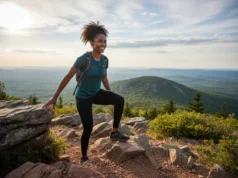In this article
The search for the perfect womens hiking bottoms often feels like a frustrating, endless quest. You’re looking for a pair that offers trail-ready performance and all-day comfort, but the most common challenge is finding hiking pants for women that fit not just the trail, but your unique body shape. This frustrating gap can leave you feeling like the outdoor industry simply doesn’t design with you in mind.
Our goal is to end that frustration. We’re not just giving you a list of products; we’re giving you a decision framework to empower your choice. You will learn the fundamental attributes that define high-performance hiking pants, from fabric science to mobility engineering. We will transparently detail our “Fit & Function-First” testing methodology, showing you exactly how we evaluated pants against real-world challenges. Finally, you will get data-driven recommendations specifically mapped to solve the most common fit problems for Curvy, Petite, Tall, and Plus-Size hikers, ensuring you find the perfect pair to fuel your trail adventures.
What Truly Matters in a Pair of Hiking Pants?
Arm yourself with the expert knowledge needed to look past marketing claims and identify the features that deliver true on-trail performance and comfort. Understanding these core principles is the first step toward making a confident and informed purchase of any outdoor pants.
Why Does Fabric Choice Make or Break a Hiking Pant?
The material of your pants is the foundation of their performance, directly impacting your comfort and safety. The industry standard is a synthetic blend, typically combining durable Nylon for exceptional abrasion resistance with a percentage of Spandex for essential stretch. This combination is quick-drying and excels at wicking moisture away from your skin, keeping you dry and comfortable during long hikes. In contrast, you must avoid cotton on the trail. Cotton is a liability because it absorbs sweat, dries incredibly slowly, and can lead to dangerous heat loss, or hypothermia, in cold, wet conditions.
Even a small percentage of Spandex, usually between 5-15%, provides the critical 4-way stretch needed for unrestricted movement when climbing or scrambling. It’s also vital to understand weather-specific technologies and overall weather resistance; a water-resistant DWR (Durable Water Repellent) coating is perfect for shedding light rain, while a fully waterproof membrane is necessary for sustained downpours. These fabric choices are critical, according to research on appropriate outdoor clothing from the University of New Hampshire Extension…, and should be considered as part of a complete layering system detailed in our guide to women’s hiking attire.
How is Freedom of Movement Engineered into Pants?
True freedom of movement on the trail isn’t just about stretchy fabric; it’s about smart, anatomical design. One of the most critical and often overlooked features is a gusseted crotch. This diamond-shaped piece of fabric, sewn into the crotch, eliminates the intersection of four seams, which is a common point of failure for thru-hikers logging serious trail miles. This drastically improves durability and, more importantly, prevents the fabric from pulling tight when you squat or take a high step while climbing. Another key feature is articulated knees, where darts or extra panels are sewn in to create a pre-bent shape that mimics your leg’s natural movement. This ensures the fabric moves with you, not against you, eliminating resistance during ascents. Ultimately, superior mobility comes from the combination of this mechanical design—the gussets and articulation—and the inherent properties of stretch fabric. When working together, they provide a completely unrestricted range of motion. These features are hallmarks of the best women’s hiking pants, and their importance is corroborated by technical design principles, as seen in patents for articulated garment joints…
Is Sun Protection in Clothing Really Necessary?
Absolutely. While often overlooked, built-in sun protection is a critical safety feature for any serious hiker. This protection is measured by the Ultraviolet Protection Factor (UPF) rating on a garment, which indicates how much UV radiation the fabric allows to reach your skin. A UPF 50+ rating is the industry gold standard, blocking at least 98% of the sun’s rays and allowing only 2% (1/50th) or less to penetrate, a crucial feature for light-skinned women or anyone on hot weather hikes.
The importance of this feature cannot be overstated; as explained by the Skin Cancer Foundation…, UPF-rated clothing provides consistent, reliable protection that doesn’t wear off like sunscreen. This is especially crucial during long day hikes at high altitudes or in exposed environments like deserts or a windy summit, where sun exposure is intense. Think of it as a permanent, full-coverage shield for the skin your pants cover, which should be combined with other protection like a proper hiking hat.
How We Tested and What We Looked For
Building these recommendations required a process that is both rigorous and transparent, ensuring you can trust our findings completely.
Our first commitment is to objectivity. All our recommendations are the result of independent research and intensive, hands-on testing. We are a reader-supported resource, and our only goal is to help every hiker find the right gear for their needs. We don’t answer to brands; we answer to you, our community of fellow hikers.
Every pair of pants we evaluated was judged against a consistent evaluation framework built on the critical performance attributes detailed above. We prioritized three core criteria: Fit and Body Type Compatibility, which assesses how well a pant accommodates different shapes; Mobility and Comfort, which measures freedom of movement and on-trail feel; and overall Durability, which evaluates how the materials and construction stand up to real-world abuse on abrasive hikes.
Our testing methodology was designed to replicate the varied conditions you face on the trail. Each pant was field-tested for weeks across diverse terrain, from the rocky, high-altitude trails of the mountains to the humid, overgrown paths of the Southeast woods. Our testers climbed, scrambled, hiked through unexpected rain, and brushed against abrasive rock and vegetation to see how each pair held up in the real world, not just in a controlled lab environment.
Finally, we translated this wealth of data into practical recommendations. The goal of this intensive process was to move beyond generic “best of” lists that ignore the most important factor: you. We analyzed our findings to create clear, actionable solutions for the four most common and frustrating fit challenges that female hikers face, connecting specific products to specific problems.
The Best Hiking Pants for Women of 2025: Our Top Picks
Our recommendations are organized as solutions to specific fit-related problems. We’ve done the research to help you find a pair of high-performance hiking pants womens style engineered not just for the trail, but for your body type.
Best for “The Curvy Trailblazer” (Eliminating Waist Gap)
The Prana Halle Pant II has earned its legendary status by consistently delivering an excellent fit for curvy body types, directly addressing the dreaded “waist gap” issue. Its design genius lies in a mid-rise waist and a straight-leg cut that provides ample room through the hips and thighs while still hugging the waist. This is enhanced by an integrated, low-profile belt that allows for precise adjustments without the bulk of an external belt that can chafe under a backpack waist strap. Made from Prana’s durable, quick-drying Stretch Zion™ fabric with a gusseted crotch and articulated knees, it offers a full range of motion. The only significant drawback is that the zippered thigh pocket on these womens cargo hiking pants is notoriously too small for most modern smartphones.
PROS
- Excellent, gap-free fit for curvy figures
- Versatile for both hiking and travel
- Quick-drying and wrinkle-resistant fabric
- Integrated belt for a perfect waist fit
CONS
- Thigh pocket is too small for modern phones
- Buttons have been known to fall off
- Can become looser after extended wear
For those who prefer an engineering-first solution, the Fjällräven Keb Trousers in the dedicated “Curved Fit” are purpose-built to solve fit issues. This model provides more generous room in the hips and seat with a higher rise in the back, a combination specifically designed for hourglass and pear shapes to completely eliminate the waist gap. The Keb Trousers are a masterclass in durability, featuring ultra-tough G-1000 fabric on high-wear areas like the knees and seat, which is then strategically combined with flexible stretch panels for mobility. Their standout feature is the large, zippered ventilation openings that run from hip to knee, offering unmatched temperature regulation on strenuous trails. The trade-offs are a very high price point and the fact that the G-1000 fabric feels stiff out of the box, requiring a break-in period.
PROS
- Purpose-built “Curved Fit” eliminates waist gap
- Exceptional durability with G-1000 reinforcement
- Unmatched temperature control with hip-to-knee vents
- Extremely practical and spacious pockets
CONS
- Very high price point is a major investment
- Stiff G-1000 fabric requires a break-in period
- Heavier than typical nylon hiking pants
Best for “The Petite Explorer” (Proportional Fit & Correct Inseam)
The Outdoor Research Ferrosi Pants are a near-perfect solution for the two biggest challenges petite hikers face: length and bulk. The widely available 29- or 30-inch “Short” inseam option solves the primary issue of excess fabric bunching at the ankles. This is complemented by drawcord-adjustable ankle cinches that allow for further customization and prevent the hem from dragging on the trail. Made from an exceptionally lightweight, breathable, and stretchy ripstop fabric (with 14% spandex), the Outdoor Research Ferrosi pants provide full mobility and a “barely-there” feel that doesn’t overwhelm a smaller frame on warm hikes. Be aware that the fit can sometimes be inconsistent between design updates, and the thin, highly breathable material may not provide enough wind resistance for cold, blustery conditions without a base layer.
PROS
- Excellent short inseam options for a perfect length
- Extremely lightweight, breathable, and comfortable
- High spandex content offers fantastic mobility
- Ankle cinches provide further adjustability
CONS
- Thin fabric may not be warm enough for cold wind
- Fabric can pill in high-abrasion areas
- Fit can be inconsistent between model years
Best for “The Tall Trekker” (Finding a Long Enough Inseam)
The Eddie Bauer Guide Pro Pants are a go-to for many tall hikers because they are an affordable, accessible, and effective solution. They directly solve the core problem by being consistently available in a dedicated “Tall” size with a 34- or 35-inch inseam, providing ample length to cover ankles from sun, scrapes, and insects. The performance is solid, featuring a lightweight, two-way stretch Flexion fabric with a StormRepel® DWR finish for water resistance and FreeShade® UPF 50+ for sun protection. For the price, it is one of the best-value and most popular hiking pants on the market. The main consideration is that the cut is relatively straight, meaning hikers who are both tall and curvy may still experience some gapping at the waist.
PROS
- Dedicated “Tall” inseam up to 35 inches
- Excellent value for the performance offered
- Lightweight, stretchy, and highly comfortable
- Effective DWR finish and UPF 50+ protection
CONS
- Straight cut may gap on tall, curvy hikers
- Women’s version lacks back pockets
- Stitching quality can be a concern for some users
For very tall women who need maximum durability and customizability, the Fjällräven Vidda Pro Trousers are one of the few truly outstanding off-the-rack solutions. These Pro Trousers are available in a “Long” inseam and, crucially, a “Raw” unhemmed length that can be tailored to fit inseams of 36 inches or more. This is a game-changer for anyone who has struggled to find adequate length. Constructed from the legendary, ultra-durable G-1000 fabric with reinforced knees and seat, these trousers are built to withstand the most rugged off-trail adventures, mountaineering, or even trail work. However, these are serious trousers with serious trade-offs: they are heavy, expensive, and can be too hot for peak summer hikes. Their water resistance is also dependent on user-applied Greenland Wax.
PROS
- “Raw” length option for a fully custom inseam
- Unmatched durability for the toughest conditions
- Reinforced knees and seat for abrasion resistance
- A multitude of highly functional pockets
CONS
- Heavy and can be too hot for warm climates
- High price point reflects their robust build
- Not inherently waterproof; requires waxing
Final Considerations & Common Mistakes to Avoid
Before you make your final decision, keep these expert tips in mind. They will help you avoid common purchasing errors and ensure you get the best performance and value from your investment.
First, don’t confuse “water-resistant” with “waterproof.” A DWR finish is designed to shed light rain and will keep you dry in a brief shower, but it will eventually fail in a sustained downpour. If you frequently hike in very wet weather, you will likely need a true waterproof shell pant to wear over your hiking pants, not just a water-resistant pair.
Next, prioritize pockets that actually work for you. Think about your system and what you need to access quickly. If you rely on your phone for navigation, having women’s hiking pants with pockets that are secure and accessible is non-negotiable. Don’t settle for pants with shallow, useless pockets that can’t accommodate your essentials.
Also, be sure to invest in durability that matches your hiking style. If your backpacking trips often take you through overgrown trails or rocky, abrasive terrain, investing in long-lasting hiking pants with reinforced panels, like the Fjällräven models, will pay for itself. For well-maintained trails, a lighter-weight fabric may be perfectly sufficient.
Finally, and perhaps most importantly, read return policies carefully. Given the high probability of fit issues when buying any piece of technical clothing online, always purchase from a retailer with a clear, fair, and easy return policy. The initial purchase is often just the first step in the process of finding that perfect, confidence-inspiring pair.
Frequently Asked Questions
What kind of pants should I wear for hiking?
You should always wear pants made from synthetic materials like nylon or polyester, blended with a small amount of spandex for stretch. These fabrics are durable, moisture-wicking, and quick-drying, which are essential for safety and comfort on the trail. For a great all-around option that works for most conditions and activities, the Outdoor Research Ferrosi Pants are an excellent choice.
Are leggings a good choice for hiking?
Leggings can be very comfortable for hiking due to their unmatched stretch, but they come with trade-offs. Standard yoga leggings often lack the durability to withstand abrasion from rocks and branches, offer little protection from wind or rain, and rarely have useful pockets. If you prefer the fit of a legging, look for thicker, more durable trek pants women’s style, often called a “hiking tight,” which will offer better performance than a basic gym legging.
How do I find hiking pants that don’t gap at the waist?
To avoid the frustrating “waist gap,” look for pants specifically advertised with a “curvy fit.” You can also seek out models that feature a higher-rise waist combined with an integrated belt or an internal drawstring system for a more customized fit. The Prana Halle Pant II is famously one of the best and most popular options on the market for solving the waist gap problem for curvy hikers.
How much should I expect to spend on a good pair of hiking pants?
You can find solid, entry-level hiking pants for around $60-$90, like the popular Columbia Saturday Trail Stretch pants, and these are often perfectly adequate for the casual day hiker. High-performance models with premium fabrics, advanced features like zippered vents, and more precise fits typically cost between $90 and $200+. For an excellent balance of price, performance, and features, consider a model like the REI Co-op Trailmade Pants.
Risk Disclaimer: Hiking, trekking, backpacking, and all related outdoor activities involve inherent risks which may result in serious injury, illness, or death. The information provided on The Hiking Tribe is for educational and informational purposes only. While we strive for accuracy, information on trails, gear, techniques, and safety is not a substitute for your own best judgment and thorough preparation. Trail conditions, weather, and other environmental factors change rapidly and may differ from what is described on this site. Always check with official sources like park services for the most current alerts and conditions. Never undertake a hike beyond your abilities and always be prepared for the unexpected. By using this website, you agree that you are solely responsible for your own safety. Any reliance you place on our content is strictly at your own risk, and you assume all liability for your actions and decisions in the outdoors. The Hiking Tribe and its authors will not be held liable for any injury, damage, or loss sustained in connection with the use of the information herein.
Affiliate Disclosure: We are a participant in the Amazon Services LLC Associates Program, an affiliate advertising program designed to provide a means for us to earn advertising fees by advertising and linking to Amazon.com. As an Amazon Associate, we earn from qualifying purchases. We also participate in other affiliate programs and may receive a commission on products purchased through our links, at no extra cost to you. Additional terms are found in the terms of service.





